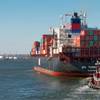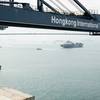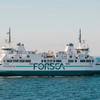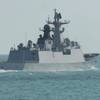Repairs to Carrier's Anchor Windlass Completed in Record Time
Puget Sound Naval Shipyard & Intermediate Maintenance Facility employees and ship’s force worked together to repair the anchor windlass on USS Nimitz (CVN 68) in about a third of the time it took previously.
The anchor windlass is comprised of motors, gears and other parts responsible for the controlled lowering and raising of the chain and anchor, which can weigh up to 200,000 pounds on a Nimitz-class aircraft carrier. It's a difficult job that requires much planning and complicated execution.
According to Shawn Carragher and Zac Malone, zone managers, Code 312, Aircraft Carrier Program Office, who were part of recent windlass repairs on USS Theodore Roosevelt (CVN 71), it required 78 days to complete. This time, the repair took 25 days, as part of a non-CNO upkeep period.
“When the project team received word the starboard anchor windlass experienced a material failure, we had to assume the repair scope would be similar to the CVN 71,” said Chris Krueger, assistant project superintendent (topside), Nimitz Project. “Utilizing the hot wash from CVN 71, the Nimitz met with shipyard stakeholders weekly to incorporate lessons learned from the Theordore Roosevelt repair into technical work documents, and to develop executable plans to efficiently complete the repair within the bounds of the upkeep.”
The job requires the expertise and close collaboration with ship’s force (A-Division and 1st Division), as well as Shop 38, Marine Machinists, Shop 11, Shipfitters, Shop 26, Welders, Code 740, Riggers, Shop 56, Pipefitters, Shop 57, Pipe Insulators, Shop 71, Painters, Blasters and Tilesetters, Code 260.3, Deck Machinery and Hydraulics, and Code 246, Test and Work Control Engineering Division.
According to Jason Turner, supervisor, Shop 38, some structural components, motors and hydraulic piping had to be moved to bring in parts and make a workspace for mechanics. Also, all gear oil and hydraulic fluid in systems related to or near the windlass work area had to be drained. Shops 11 and 26 also welded pad eyes on the deck of the windlass space to allow the riggers to manipulate reduction gear as it was relocated to an open area.
“All of this work had to be done before the riggers and shipwrights could install a wood floor on the deck to protect the surrounding structure in the space as the reduction gear was moved,” said Carragher. “The reduction gear was rigged and had upper casing removed, and Shop 38 inspected, cleaned, and repaired any broken parts within the gear case. Once the close-out inspection was complete, the upper casing was installed and bolted together. Only then could the reduction gear be rigged into place and bolted down.”
Carragher said welding structural items in place and reinstalling hydraulic piping accounted for the longest leg of the restoration efforts. As soon as interferences were reinstalled, the ship and Shop 38 filled the reduction gear with gear oil and the hydraulic system with hydraulic oil. Once all repair efforts were complete, a no-load test was performed, followed by a final load test.
Malone said the efforts of ship’s force helped the team make the repair in such a short amount of time.
“A-Division and 1st-Division removed paint, hydraulic piping, and drained fluids from the hydraulic system and reduction gear prior to the ship’s arrival at Bremerton,” said Malone. “Their efforts saved at least a week of shipyard production efforts and contributed greatly to the speed and success of the repairs.”
Due to their complexity, anchor windlass reduction gear casings are normally not worked on unless a failure occurs.
“Rigging is difficult due to the size, shape, and weight of the parts that need to be moved,” said Mike Apodaca, supervisor, Code 740. “Our riggers have to be creative in selecting rigging paths and methods used so as to not injure personnel or cause further damage to the reduction gear. Also, our Shop 38 team put forth a great effort to work around these parts to successfully repair what had broken.”
USS Nimitz got underway on time August 13, fully capable to support the mission.














